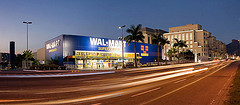Wal-Mart, urban design, Main Street, jobs, and eye care

Photo by Fernando Stankuns on Flickr.
Wal-Mart is planning four stores in the District, in areas varying in walkability from dense New Jersey and H Streets, NW to Brightwood and East Capitol to the very auto-oriented New York Avenue.
Lydia DePillis has stayed on top of one question on the minds of many who care about walkable development: could these Wal-Marts be friendly to the urban landscape, or just more “Sprawl-Mart”?
So far, Wal-Mart has rarely built good urban models. It takes some lobbying for them to sacrifice surface parking and embrace multi-story buildings (see this rendering of the Wal-Mart planned in Baltimore City), despite the way a company of such magnitude ought to at least fake an interest in good urban building practices.
Of course, Wal-Mart’s impact will go far beyond the built environment. Will it be good or bad for DC?
Wal-Mart forces suppliers to cut their prices down to the bone, which negatively effects the national and international economy. Wal-Mart isn’t “Main Street”-friendly, and a healthy, diverse commercial corridor is important to the vitality of a dense, urban neighborhood.
My largest concern is that Wal-Mart will obliterate any efforts to jump-start a hyper-local economy. Empty storefronts are a big issue. In working in Anacostia, I’ve realized that getting a business into a formerly-empty space makes people feel good about their neighborhood. ANC 8C commissioner William Ellis had hoped Wal-Mart would look at Howard Road, by the Anacostia Metro, because of the 295/395 access. It’s fortunate that’s not one of the sites since it would also stall the renaissance that is, albeit slowly, finally looking possible for Good Hope Road and Martin Luther King Boulevard.
Many individuals that I’ve spoken with in Anacostia are interested in seeing their commercial corridor turn into more than empty storefronts (of which there are more than a few). But, Wal-Mart is not going to fill up any existing empty spaces. It’s going to plunk itself down somewhere with plenty of yardage and make people come to it. Wal-Mart makes you feel good about saving money, but it’s not your neighbor.
In marginalized communities, banks consider necessary loans too high-risk to grant, or the entrepreneur thinks there won’t be a strong enough customer base. The presence of Wal-Mart could alleviate those concerns. But, it could also singlehandedly quash organic growth in the area. This could be most problematic in the location planned for Georgia and Missouri Avenues, an area where Wal-Mart could leave empty many small-business storefronts.
However, the behemoth will bring jobs. Underserved parts of DC need jobs and “Main Street” can’t provide stable employment on such a massive scale. Though the DC Council will probably have to force them do to it, Wal-Mart can afford to pay hundreds of workers a living wage. Given the overhead costs for Mom and Pop, living wages are not always a possibility.
There’s already a Wal-Mart inside the Beltway in Prince George’s, and the District is likely losing tax revenue because people drive out there now, as it is. Shouldn’t we keep that local?
Though there are more than a few criticisms of the way the Wal-Mart brings goods and services, they do put those amenities within the reach of shoppers who might not otherwise afford it. Those with groceries, like the ones planned for DC, can make fresh produce accessible. Some Wal-Marts even offer eye examinaions and fill contact lens orders. If one-stop shop also includes better access to optical care, that’s beneficial.
In 2004, Ward 5 residents thwarted a potential effort from Wal-Mart; the company then claimed the space they were looking to occupy was actually too small. There’s plenty to hate—and conversely, plenty to love—about Wal-Mart, but this time its impending arrival is inevitable. Locations are coming en masse and the economy is not as flush as it was six years ago. Despite evidence that indicates that the number of jobs the retailer provides is harder to calculate than it seems, turning down Wal-Mart will look like turning down a couple hundred job opportunities. That doesn’t look good for anyone beholden to a constituency that’s largely out of work.
Given the circumstances, the best we can do is demand that, when Wal-Mart hulks its way into the District in 2012, it offer our residents living wages and a well-designed, urban-friendly space.
